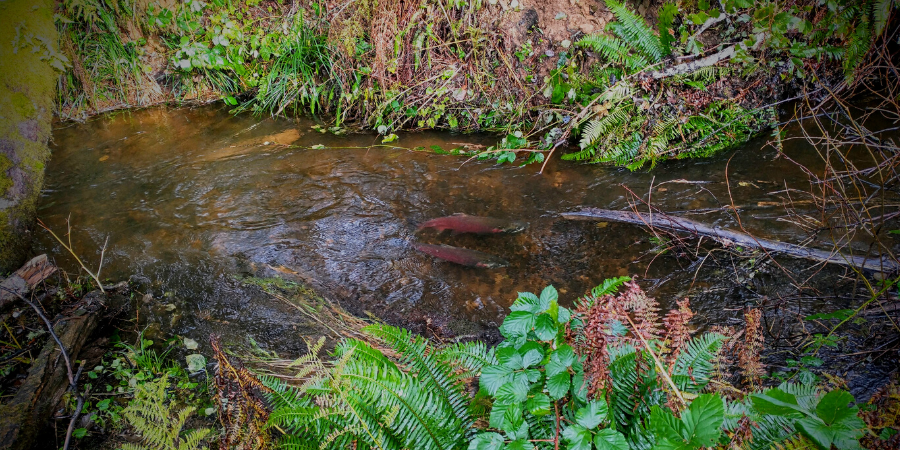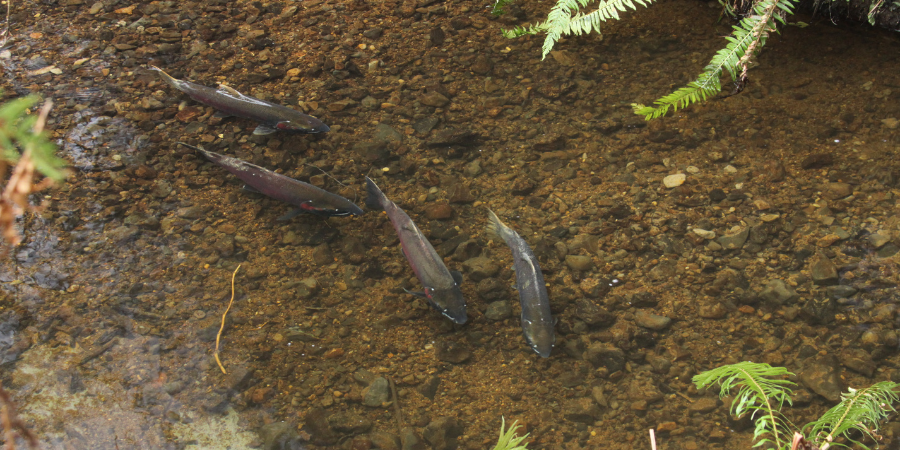
Salmon spotted Nov. 7 in Thompson Creek as they make their return to spawn this fall.
Fall means many things on the Oregon Coast. A significant one, in the natural world, is the return of salmon, who migrate from the Pacific Ocean to inland streams and creeks to spawn.
The importance of this annual occurrence has long been celebrated and valued by those who call the Pacific Northwest home. According to the Columbia River Inter-Tribal Fish Commission, “Salmon play an integral part of tribal religion, culture, and physical sustenance.” They are central to indigenous views and values regarding sustainability, regeneration, and balance.
Salmon—and the return of the salmon each fall—are hugely important to sustaining life and cultivating well-being; thus, salmon are cared for and honored in ceremony, as well as fishing practices, by indigenous people of the Pacific Northwest.
The Chinook Nation and the Clatsop-Nehalem Confederated Tribes, and many others in the region, hold various First Salmon ceremonies honoring the Columbia River salmon. Although there are distinctions among the ceremonies, they are tied by a common thread of thinking and understanding.
More than just a food source, salmon—and the practices surrounding them—are symbolic. For example, rules such as never taking the first or last salmon of the run embody the respect tribal members have for the land and waters, their bounty, and other living creatures. It reflects an understanding that sources of food aren’t infinite.
The salmon devote the ends of their lives to procreating, carrying on the species, and providing a source of nourishment to humans and the ecosystem. It is our responsibility to show the same respect and care.
Here is more information from the commission, as stated on their website, regarding some of the ways the salmon is sacred to Pacific Northwest tribes:
- Salmon are part of our spiritual and cultural identity.
- Over a dozen longhouses and churches on the reservations and in ceded areas still use salmon for their religious services.
- The annual salmon return and its celebration by the tribes assure the renewal and continuation of human and all other life.
- Historically, we were wealthy peoples because of a flourishing trade economy based on salmon.
- For many tribal members, fishing is still the preferred livelihood.
- Salmon and the rivers they use are part of our sense of place. The Creator put us here where the salmon return. We are obliged to remain and to protect this place.
- Salmon are indicator species: As water becomes degraded and fish populations decline, so too will the elk, deer, roots, berries and medicines that sustain us.
- As a primary food source for thousands of years, salmon continue to be an essential aspect of our nutritional health.
- Because our tribal populations are growing (returning to pre-1855 levels), the needs for salmon are more important than ever.
- The annual salmon harvest allows the transfer of traditional values from generation to generation.
- Without salmon returning to our rivers and streams, we would cease to be Indian people.

In early November, we got to celebrate the return of the salmon for this year. Heavy rains filled the rivers and creeks in our local area, spurring the salmon’s journey back upstream around the Necanicum Estuary and elsewhere on the northern Oregon Coast. Wanting to welcome them back, our staff visited the Thompson Creek Habitat Reserve in northern Seaside.
We were hopeful we would spot some salmon and redds, the gravel nests where the females lay their eggs before passing away. Sure enough, on our visit, we spotted several coho salmon—both male and female—in the creek, along with what appeared to be a redd.
Here are a few other interesting facts about salmon:
1. Oregon is home to numerous salmon species.
There are several species of Pacific salmon that are native to Oregon, including Chinook, coho, chum, sockeye, Kokanee, coastal cutthroat, and pink salmon. Coho and Chinook are the most populous species. And there are no remaining breeding grounds for pink salmon, although they’ll still occasionally show up in the Columbia River.
2. Salmon spend their lives in both freshwater and saltwater habitats, which requires physical transformation.
Salmon are hatched and reared in freshwater systems—such as rivers, creeks and streams—before journeying to the Pacific Ocean in their youth. Their bodies can metamorphosize to migrate from their freshwater habitat to the salty ocean water. However, it doesn’t work in reverse. When they reenter to the freshwater system to spawn, their bodies start to decay. You may spot salmon who are extremely decayed, particularly the further you get upstream.
3. Salmon try to start and end their life in the same place.
Salmon engage in what is known as natal homing. After spending several years in the ocean and reaching sexual maturity, most salmon will attempt to return to the same freshwater stream or river where they were born in order to reproduce. There are various hypotheses about why they do this and how they are able to. For example, salmon memorize the scent of their natal site when they’re young and use that scent to guide them back home later in life.
4. Death of the salmon upstream feeds the ecosystem.
The spawning process involves the female building a redd in the gravel and sand using her tail to move the stones and create a depression that will help protect the eggs. The female lays her eggs as the male simultaneously releases his milt. The male salmon can court and spawn with multiple females. Soon after spawning, both will pass away—a natural part of their life cycle, which typically spans two to five years, depending on an array of factors. As they decay, the salmon carcasses supply nutrients to the entire surrounding ecosystem. In fact, scientists have found traces of nutrients derived from the open ocean—and brought inland by salmon—in old-growth trees along the Pacific Coast!
Sources and Further Reading:
Chinook Nation, First Salmon Ceremony
Confederated Tribes of Siletz Indians
Clatsop-Nehalem Confederated Tribes
Columbia River Inter-Tribal Fish Commission
“The Sociocultural Significance of Pacific Salmon for Tribes and First Nations,” Earth Economics
“First Foods: How Native people are revitalizing the natural nourishment of the Pacific Northwest,” The Seattle Times
Comments